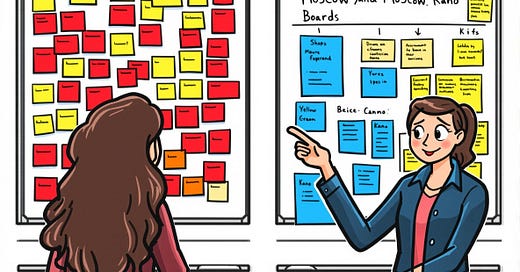How I Stopped Prioritizing Like a People-Pleaser and Started Shipping What Matters
The Prioritization Mistake That Cost Me 20 Hours—and How I Fixed It for Good
🚨 The 20-Hour Mistake I’ll Never Forget
We had a login bug.
Users were getting locked out—some permanently. But sitting pretty at the top of the backlog? A shiny new dashboard animation that everyone loved. It looked impressive in demos, felt fresh, and had buzz.
So I prioritized it.
That decision cost us 20 hours in hotfixes and a team-wide trust breakdown. The devs were right to ask:
“Why are we shipping fluff when core features are broken?”
Bad prioritization doesn’t just waste time—it breaks confidence. It turns planning into firefighting. And it happens way more often than most teams like to admit.
According to PMI (2025), 65% of projects fail due to poor prioritization. That stat isn’t a red flag. It’s a full-blown siren.
So I changed how I plan.
Here are the exact methods I wish I had from the beginning.
Why Prioritization Fails
Here’s the truth no one puts in the sprint retros:
Most teams don’t prioritize based on logic. They react to pressure.
Someone with influence drops a “quick idea” in a meeting. The flashiest feature gets pushed to the top. You agree—partly because it sounds exciting, partly because arguing feels like too much work.
But without clear criteria? That’s not strategy. It’s roulette.
Here are the traps I’ve fallen into—and seen repeated across multiple teams:
No Criteria: Gut decisions like “this feels cool” or “users might love it” result in confusion, not alignment.
Stakeholder Bias: The loudest voice skews the plan—and you build for opinions instead of outcomes.
Scope Creep: Low-value work sneaks in, critical bugs get ignored, and velocity tanks.
The worst?
Letting opinions override what the data is clearly telling you.
I’ve done it. You probably have too.
Let’s fix that.
The 3 Methods That Changed My Backlog
1. MoSCoW: Clear Language. Quick Wins.
Must-have. Should-have. Could-have. Won’t-have.
It sounds simple—but that shared language changed everything.
We once downgraded a cosmetic UI tweak to “Could-have” and prioritized fixing broken login logic. That one change saved 10 hours—and defused a near dev mutiny.
Why it works:
It forces clarity. Everyone speaks the same prioritization language. No more circular debates—just faster decisions and focused delivery.
2. Kano Model: Prioritize What Actually Feels Right
Some features delight users. Others are just expected.
Kano helps you see the difference—before wasting dev cycles.
We used it to ditch a planned animation and refocus on checkout performance. The result? A 15% jump in user satisfaction and a noticeable drop in complaints.
Why it works:
It shifts the question from “What’s exciting?” to “What creates real value?” You stop chasing dopamine and start delivering substance.
3. Weighted Scoring: Turn Opinions into Data
Assign scores to features based on impact, effort, and risk.
One integration was on the verge of being cut. But scoring revealed it was critical to avoiding a two-week delay. It made the decision obvious—and saved the sprint.
Why it works:
You replace gut feelings with clear numbers. Everyone sees the logic. Disagreements turn into data-driven discussions.
The Payoff
Let me be honest: I still mess up. When I skip these frameworks or rush a call, I feel the fallout fast.
But when we committed to them?
Delivery sped up
Rework disappeared
Team trust rebuilt itself
Stakeholders became more strategic
The backlog stopped being a battleground.
It became a tool for clarity.
Most teams lose 25–30% of sprint effort to bad prioritization. You don’t have to be one of them.
Try This Today
Start with MoSCoW in your next sprint planning. Seriously—just that.
You’ll see the fog lift almost immediately. Once your team’s on board, layer in Kano or scoring based on your product maturity.
These 3 methods helped me align five separate teams—without a single priority fight. That’s rare. But repeatable.
Smart prioritization will define Agile leadership in 2025. The sooner you master it, the faster you lead.
Before You Go
✅ MoSCoW — Aligns conversations
✅ Kano — Identifies real value
✅ Scoring — Removes bias
These three flipped my roadmap from reactive chaos into proactive control.
Now your turn:
What’s the blind spot in your current prioritization process?
I share weekly insights to sharpen your Business Analysis skills, boost your project impact, and help you own every stakeholder conversation with confidence.
Join 60+ subscribers (and growing) for no-nonsense advice, practical tools, and real strategies that get results.
🎁 Coming soon: Templates, checklists, and frameworks designed to make your BA work smoother and smarter.
🔗 Follow me on LinkedIn for fresh perspectives, content tips, and honest creator vibes.
👉 Restack this post — someone in your team needs to read it.
👇 Subscribe for more BA/PM insights strategies that cut fluff and boost delivery.



